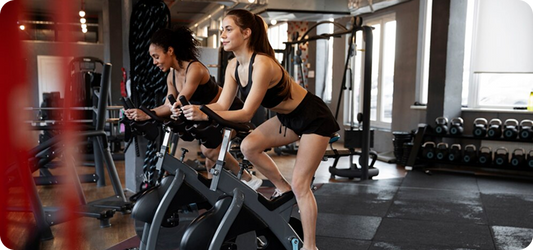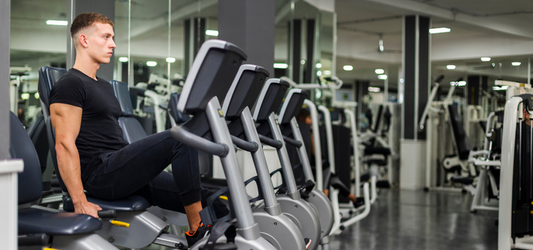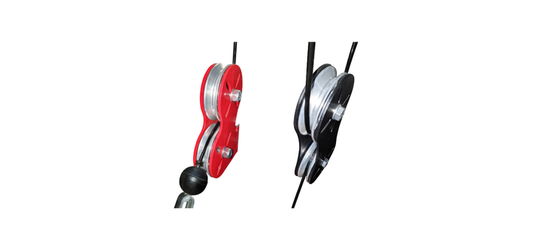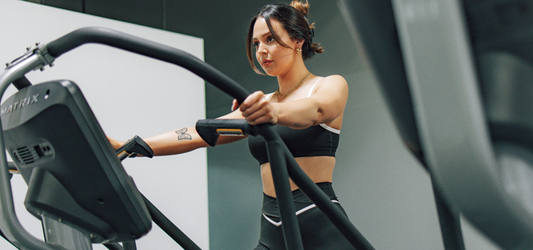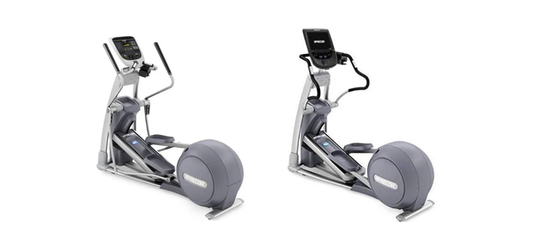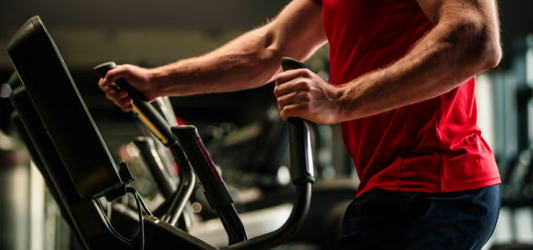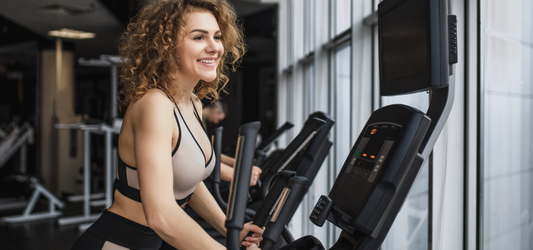Whether you're a beginner or a seasoned gym owner, we've got you covered with expert tips on how to maximize each piece of equipment to achieve your fitness goals! From selecting the perfect gear to crafting tailored workout routines, our blog is your ultimate resource for unlocking your full potential
Lifting weights consistently but not seeing results? Your muscle fiber composition might be the key factor. To a large extent, fiber types predict the athletic activities best suited for you. A HIIT trainer, for example, may have 80% fast-twitch and 20% slow-twitch muscle fibers, while a yoga instructor may have the reverse.
In strength training, achieving optimal results requires a comprehensive understanding of the intricate components that make up our muscles.One crucial aspect that often goes overlooked is muscle fibers and their respective roles in our physical performance.
This article aims to shed light on why learning about muscle fibers is vital for anyone committed to a successful workout regimen. We will delve into the definition of muscle fibers, their functions, the different types, and how engaging them strategically can lead to superior strength training outcomes.
Why Should You Know About Muscle Fibers?
Image Source
The human body is a marvel of complexity, and understanding its inner workings is key to maximizing physical potential. Muscle fibers play a pivotal role in this context, as they are the fundamental units responsible for muscle contraction and movement.
In fact, 30% to 40% of the human body is composed of skeletal muscle tissues. These skeletal muscles include shoulder muscles, hamstring muscles, and abdominal muscles– all of which are part of the typical focus areas among workout warriors. In addition, knowing about muscle fibers is essential for:
1. Optimizing Workouts
Tailoring workouts to target specific muscle fibers can lead to more efficient and effective training sessions. A comprehensive understanding of muscle fiber types will help you design workout routines that cater to your personal fitness goals, whether it's strength, endurance, or a combination of both.
2. Preventing Imbalances
Imbalances in muscle development can lead to injuries and hinder overall performance. Knowledge of muscle fibers enables individuals to address specific areas that may be lagging behind.
3. Fine-Tuning Nutrition
Different muscle fiber types have varying energy demands. Knowing the predominant fiber types in your muscles can help you fine-tune your nutrition to support your training goals.
What Are Muscle Fibers?
Image Source
Each skeletal muscle is an intricate network of hundreds or even thousands of muscle fibers, enveloped by connective tissue. These muscle fibers consist of smaller units known as single muscle cells, composed of thick and thin filaments (myofibrils).
Muscle fibers are responsible for executing voluntary movements, making them integral to various bodily actions. Its primary functions include:
● Muscle Contraction - Muscle fibers contract in response to signals from the nervous system, generating the force required for movement.
● Energy Production - Muscle fibers utilize different energy systems, such as the aerobic and anaerobic pathways, depending on the type of contraction and duration of the activity.
● Postural Support - Certain muscle fibers are crucial for maintaining posture and stability, providing the foundation for all movements.
The three main types of muscle fibers are skeletal, smooth, and cardiac, with skeletal muscle fibers being the focus in strength training.
Types of Skeletal Muscle Fibers and Their Roles
Image Source
Skeletal muscle fibers are categorized into two primary types: Type I and Type II, with Type II further divided into subtypes II A and II B.
Type 1, or slow-twitch muscle fibers: Exhibit greater resistance to fatigue and are primarily engaged in sustained, smaller movements and posture control.
Type 2, or fast-twitch muscle fibers: Generate larger and more forceful contractions but fatigue more rapidly in shorter durations.
Every individual possesses unique compositions of muscle fiber types, influencing their performance in various activities. To better illustrate their differences:
● Type I (Slow-Twitch) Muscle Fibers
○ Characteristics: Endurance-oriented, smaller in size, high resistance to fatigue.
○ Roles: Well-suited for prolonged, low-intensity activities like marathon running or maintaining posture.
● Type IIa (Fast-Twitch Oxidative) Muscle Fibers
○ Characteristics: Intermediate size, a balance between endurance and strength.
○ Roles: Engaged in activities requiring both endurance and strength, such as middle-distance running or high-intensity interval training (HIIT).
● Type IIb (Fast-Twitch Glycolytic) Muscle Fibers
○ Characteristics: Large in size, quick to fatigue.
This summary shows us how each muscle fiber type aligns with specific activities. However, it doesn’t mean that being Type I makes it impossible for you to lift heavy weights and immerse in strength training. Rather, a person’s muscle fiber type is influenced by other factors such as activity level and age.
The good news is that you can modify your muscle fiber type composition through targeted workouts. Doing extra endurance training is effective for developing Type I fibers, while increasing your strength training routines can fully activate Type II fibers.
Benefits of Balanced Focus on Different Muscle Fibers
Image Source
Adopting a well-rounded routine targeting the different muscle fibers offers numerous advantages, including:
Injury Prevention: Balanced workouts distribute stress across muscles, reducing the risk of overuse injuries and enhancing joint stability.
Improved Posture: Engaging all muscle groups contributes to better body alignment and balance, fostering improved posture and minimizing strain on the spine and supporting structures.
Prevention of Muscle Imbalances: Addressing all muscle groups averts imbalances that can lead to functional limitations and injuries.
Alleviation of Aches and Pains: A balanced routine promotes overall muscular flexibility and joint mobility, reducing general aches and discomfort.
Enhanced Strength and Performance: Comprehensive muscle engagement leads to improved overall strength and performance, enhancing functional movements and athletic abilities.
Accelerated Muscle Growth: Working on diverse muscle groups facilitates a more comprehensive muscle-building process, encouraging symmetrical development and accelerating overall muscle growth.
To reap these benefits, understanding your current muscle fiber types is crucial. Tailoring your workout routine to modify or solidify your composition based on fitness goals is an essential step towards achieving holistic strength and fitness.
How to Engage Muscle Fibers for Optimal Strength Training Results
Image Source
Unlocking your body's full potential relies on an understanding of how to effectively engage your muscle fibers. Here are four key strategies that can significantly enhance your strength training outcomes:
1. Apply Varied Training Approaches
Embrace a diverse range of exercises, including resistance training, cardio, and weight lifting. By engaging different muscle fiber types through this varied approach, you will gain insights into your primary fiber type composition.
This understanding is crucial as it provides visible and quantifiable outcomes quickly. Armed with this knowledge, you can then fine-tune and recalibrate your workout routines to align with your body's unique needs and responses.
2. Progressive Loading
Optimal muscle stimulation and growth come from gradually increasing the intensity of your workouts. By challenging your muscle fibers through progressive loading, you create a regimen that promotes both strength development and muscle growth.
This systematic approach ensures that your muscles are consistently pushed beyond their comfort zone, avoiding workout plateaus and improving your performance over time.
3. Personalize Your Training
Tailor your workout regimen to align precisely with your individual goals. Focus on the predominant muscle fiber types associated with your desired outcomes.
Whether your aim is hypertrophy, endurance, or strength, a personalized training approach allows you to address specific areas of improvement. By customizing your workouts, you can boost the effectiveness of each session, bringing you closer to your fitness objectives.
4. Prioritize Rest and Recovery
Each workout session results in tiny tears in your muscle tissues. During rest, these muscles undergo a healing process, becoming stronger in the recovery phase. This enhanced strength allows you to perform the same workout more efficiently and effectively in the next workout session.
On the other hand, neglecting rest days may increase the risk of prolonged periods of downtime due to potential injuries. It’s important to remember that rest days are not a sign of weakness but a strategic component of a successful training program.
Through incorporating these principles into your workout routine, you'll not only witness visible and quantifiable improvements but also cultivate a deeper connection with your body's dynamic capabilities. Practicing these strategic approaches will set you up for long-term success in consistently achieving your evolving fitness goals.
Conclusion
As constantly active workout warriors eager to boost your strength, understanding the nuances of muscle fibers is a game-changer. Armed with this knowledge, you can create personalized training programs, fine-tune your fitness routines, and ultimately achieve superior results in strength training.
By appreciating the roles of different muscle fiber types and strategically engaging them, you can unlock their full physical potential and head towards a stronger, more resilient body.
Ready to #ChallengeYourself with French Fitness?
French Fitness is a leading manufacturer of fitness equipment for commercial gyms, homes, and other fitness facilities in the USA, Canada, and beyond. We offer an extensive range of products that covers everything you need in a gym, including flooring, treadmills, ellipticals, exercise bikes, steppers, stair mills, rowers, air bikes, selectorized and cross training equipment, rack and rig systems, plate loaded equipment, free weights, benches, multi-functional equipment, plyo and speed training equipment, and more.
Start challenging yourself with our top quality equipment at www.frenchfitness.com
Today’s world is all about energy conservation, and using clean and green energy that has a lower adverse impact on the environment. This has led to the advent of renewable energy resources, such as wind turbines, hydro-powered electricity, and solar energy. While scientists and engineers fiddle with the way energy is produced to power up our appliances and devices, we discuss how that energy affects the one thing we love the most - our journey to fitness.
Traditionally, most fitness equipment is operated manually, and doesn’t require any power source. However, machines like treadmills, electronic ellipticals, and most other machines that have a display of some sort need electricity to operate, and we are trying to compare two common energy sources - AC power and battery power.
Summary
Today there are numerous gyms around the world that are coming around to the idea of having their fitness equipment and machines run by batteries or alternators. This not only saves thousands of dollars in electricity costs, it also makes for a cleaner energy source.
Even for home gyms, battery-powered machines are more suitable as they allow for more portability and leave you with more options for setting up your gym. Let’s dive deeper and see how batteries and alternators are used to power up fitness equipment and make your lives easier.
Alternators
In simple terms, an alternator is an electrical generator that converts mechanical energy into electrical energy and outputs it as alternating current, or AC. Special alternators are made for exercise equipment, which are fitted to the machine to provide fixed or variable load. These are designed according to the mechanism of the exercise equipment, so it can work perfectly.
If a variable load alternator is fitted to the machine, it also adjusts the ease with which the machine can be operated, thus impacting your exercise regimen. When you start working out, the rotating mechanism of the alternator starts to rotate with the motion of the machine, and this causes it to produce AC current, which is then used to charge a battery attached to it.
Batteries
Once the alternator starts to receive mechanical energy through the rotation of the fitness machines, it starts to generate AC current, and a battery has to be attached to it that will store the current. In turn, this stored current can be used to keep the machine going for much longer, thus reducing its dependence on AC power.
Pros and Cons
Image Source
Here are some of the pros and cons that you should consider when choosing between battery-powered and AC-powered machines:
The Benefits
One of the major benefits to using battery-powered fitness equipment is that it provides a greater deal of portability that you simply can’t get with AC-powered machines. By portability we don’t imply that you get to move your machine around easily, because they are naturally very heavy. But having a battery-powered machine does give you the freedom to place it anywhere you want, be it in your basement, balcony, bedroom, or anywhere else you want. Since it doesn’t require any wall socket to plug into, you can pretty much place it anywhere you like.
Another advantage that comes from using a battery-powered machine is that you don’t have to deal with any wires or connections, and this also prevents any trip hazard. Most of the heavy gym machines require a heavy or dedicated socket, and you will have to call your electrician for that.
Another benefit is the overall lower electric bill you enjoy as you won’t be powering up your fitness equipment with AC power.
The Downsides
A major downside of battery-powered machines is the inconvenience of having to replace the batteries every now and then. No matter how good they are, batteries don’t last too long, and you will have to replace them after every few months or years, which is a recurring cost. Before you think about buying a battery-powered machine, be sure to calculate all the costs and savings.
Moreover, running out of juice can cause the machine’s memory to reboot or erase, which will cause you to lose all of your exercise data.
Another disadvantage you will experience with battery-powered fitness machines is the lack of features that they provide. Machines that run on AC power tend to be more powerful, and also have a lot more features to boast, such as preset programs, digital speed settings, and much more. If you don’t think you will be needing all of these features, you can choose battery-powered machines.
Conclusion
Whether you choose AC-powered fitness machines or their battery-powered variants, both have certain pros and cons. If you are looking for portability and ease of use without the hassle of wiring and electrical connections, then battery-powered machines are the answer.
However, if you’re not down for regularly replacing batteries, especially if you have machines with more digital features and controls, then buying AC-powered machines is a no-brainer for you. However, the end goal is, and always should be, your fitness.
The bearing of aluminum pulley is metal which is a lot sturdier and will last longer. The depth of the grooves is deeper in so the cable stays in and is a lot smoother.
The smooth surface has little friction to ensure easy movement. Affordable and wear-resistant. Sturdy and durable for long-term use. Easy to use and install. Light weight, easy to replace. Suitable for most fitness equipment, gyms, home gyms, commercial or private purposes.
The Elliptical Crosstrainer, which entered the market in the 1990's, is now the second most popular cardio machine on the market - just behind the treadmill. Fitness Superstore only carries the best ellipticals, including Precor Ellipticals, Life Fitness Ellipticals, Octane Fitness Ellipticals, and Cybex Arc Trainers. Beware of knockoffs.
Poorly designed Elliptical Trainers will feel shaky and flimsy, and do not properly oscillate the moving arms with the moving legs, causing their arms to move rapidly quick and providing for a poor, uncomfortable workout! Buy the trusted brands at Fitness Superstore, not the flimsy sporting goods store knockoffs.
For people that want a total body workout, an elliptical is a great choice of machinery. While giving you the intense workout you desire, ellipticals also help protect your joints from the wear and tears they may face when using a treadmill or running.
Ellipticals allow for a natural stride to take place during your workout, which allows for optimal comfort during and after your workout.
Benefits of Elliptical Cross-Trainers
Elliptical Cross-Trainers are great for people who want a really great low-impact cardio workout. These machines workout over 5 different muscle group all at once! Read about all the benefits here!
Benefits of Running on a Treadmill
Did you know that spending just TEN MINUTES a day on a treadmill can actually add years to your life, even if you're running at a slow pace?! Read our article to learn more about the benefits of running on a treadmill and start incorporating it into your workout!
Benefits of VersaClimbers
VersaClimbers are great for a total body workout! Versatile amongst people of all age groups, the VersaClimber takes up minimal space. Read all about the benefits of Versaclimbing!
Elliptical trainers are one of the most popular choices for a workout because they are low-impact, and combine an upper and lower body workout at the same time. At Fitness Superstore, we have a huge selection of elliptical cross-trainers for both home gyms and commercial gyms.
If you are in need of an intense, low-impact cardio workout an elliptical, we are the perfect choice for you. Find out why you should buy an elliptical, the benefits of an elliptical, and what features ellipticals have to offer at Fitness Superstore.
Benefits of Elliptical Cross-Trainers
Features of Elliptical Cross-Trainers
Why Elliptical Cross-Trainers?
Why Gym Quality Ellipticals?
History of Precor Ellipticals
Review of Life Fitness Ellipticals
About Cybex Arc Trainers
We carry brand name ellipticals that have features to help you get the best dual workout possible. Our ellipticals have programs and settings that allow for you to choose an exercise program to cater to your needs. Whether you want to interval train, or mimic hill climbing, our ellipticals have the right program for everyone.
For maximum results and comfort, an elliptical is an excellent choice of equipment. Browse through our selection of ellipticals to find the features you desire during your workout.
Excellent low-impact cardio workout
Tone and define quadriceps, hamstrings, glutes, chest, back, triceps, and biceps all at the same time
Less maintenance than a treadmill
Just 20-30 minutes a day, 3+ days a week can increase your aerobic capacity
Takes up less space than a treadmill
At Fitness Superstore, our collection of brand name ellipticals is unbeatable. Choose from new or used ellipticals to help you make the most of your workout.
